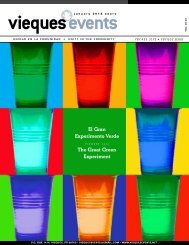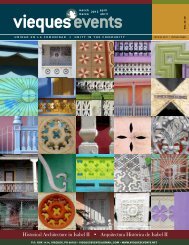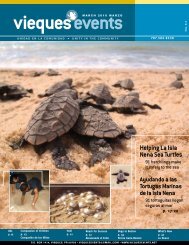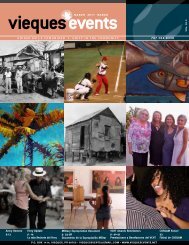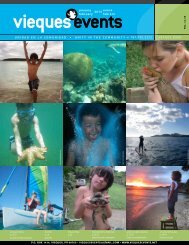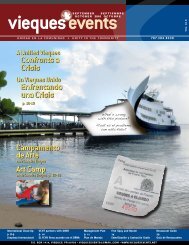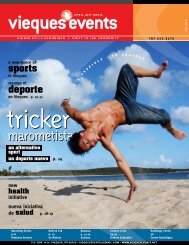alcoholics anonymous - Vieques Events
alcoholics anonymous - Vieques Events
alcoholics anonymous - Vieques Events
Create successful ePaper yourself
Turn your PDF publications into a flip-book with our unique Google optimized e-Paper software.
june / july vieques events<br />
30<br />
Historical Significance: From the moment of its activation in<br />
1899 until it closed in 1926, this lighthouse was considered one of<br />
the primary seacoast lights in all of the Caribbean. It was a key light<br />
in aiding navigation and passage between the Lesser Antilles and<br />
Cuba.<br />
Through the years: Built on top of a rocky promontory, the<br />
lighthouse was immediately undermined by the powerful forces<br />
of the sea which kept eroding the rugged cliff beneath it. The rain<br />
water cistern was constantly polluted by the powerful sea water spray.<br />
Within a few years of operation, the structure began to show structural<br />
damage. In 1920 $40,000 in emergency funds were requested<br />
by the Commerce Department to replace the lighthouse with a new<br />
one in Puerto Real. The Commerce Department wrote the following<br />
to congress: “It is urgent to rebuild a lighthouse at or near this point<br />
as this is an important aid to navigation… A light in this vicinity<br />
is necessary…” The request was denied. The lighthouse continued<br />
operating until March 9, 1926, at 4:30am, when a powerful earthquake<br />
caused irreparable damage to the structure. The building was<br />
then abandoned. An automated skeletal tower was erected next to<br />
the lighthouse. The tower supported a beacon that produced a white<br />
flash every four seconds, but due to corrosion and weather it eventually<br />
collapsed. There is no light or navigational aid on this point.<br />
Today: The lighthouse and the surrounding land are managed by<br />
the <strong>Vieques</strong> National Wildlife Refuge (VNWR). The Puerto Ferro<br />
Lighthouse is missing its lantern room. Some of the roof beams have<br />
fallen and most of the remaining ones are in poor condition. Neglect<br />
and vandalism have left this lighthouse in ruins. The Puerto Ferro<br />
Lighthouse has been added to the Lighthouse Digest Doomsday<br />
List. The VNWR is currently working with the US Coast Guard,<br />
the Puerto Rico Conservation Trust, the <strong>Vieques</strong> Conservation and<br />
Historical Trust and TICATOVE (<strong>Vieques</strong> Conservation Group) to<br />
examine the funding and feasibility of restoring the structural integrity<br />
of this light house. If this proves to be a viable option, the plan is<br />
to seek out funding, while the area is still being cleaned up by the US<br />
Navy and then allow for restoration work to begin. Although there is<br />
no current deadline, it is hoped that this will begin in 2013-2014.<br />
Both lighthouses are a great example of the official neo-classic<br />
minor lighthouse style. They are also the only Puerto Rican lighthouses<br />
built originally with two doors, of which the rear is flanked<br />
by two circular openings for air circulation. Since both lighthouses<br />
were constructed on high ground, their towers are short.<br />
These two giants of light are an integral part of our history. The<br />
Punta Mulas Lighthouse (automated light still works) is the ever<br />
fixture in and out of our port in Isabel II. And the Puerto Ferro<br />
Lighthouse is that majestic ghost on the south side that can’t be<br />
ignored. Both will continue to illuminate part of our history.<br />
The following sources were used for this article:<br />
“Puerto Ferro Light,” Kevin Murphy, Historic American Engineering<br />
Record, August, 1984.<br />
“Lighthouses of Puerto Rico”, Russ Rowlett, University of North<br />
Carolina at Chapel Hill, 2011<br />
“Lighthouse Digest: Doomsday List”, Lighthouse Digest Magazine,<br />
Lighthouse Digest and Foghorn Publishing, Tim Harrison and<br />
Kathleen Finnegan, Publishers<br />
Also on-line:<br />
Ediciones digitales: Faros PR<br />
Lighthousefriends.com<br />
Biblioteca Nacional de Espana]<br />
habían dos cuartos. Al este, había una sala y en el oeste, la habitación del inspector,<br />
oficina, almacén/cuarto de aceite, y una letrina. La cocina estaba localizada al lado<br />
opuesto del vestíbulo en el lado norte del edificio. Un lente Fresnel de quinto orden<br />
giraba mediante un mecanismo de relojería unido a un peso de 200 libras, que fue<br />
colocado en la columna central de la escalera. La blanca luz emitía un destello cada<br />
5 segundos. Sobre la entrada que daba al mar, hay una base para el poste de una<br />
bandera, que no figura en los planos originales.<br />
Significado Histórico: desde el comienzo de sus operaciones en 1899 hasta su<br />
cierre en 1926, este faro fue considerado uno de las primeras luces costeras de todo<br />
el Caribe. Era una luz clave en la ayuda para la navegación y para el paso entre las<br />
Antillas Menores y Cuba.<br />
A través de los años: Construido en el tope de un promontorio rocoso, el faro<br />
sufrió las poderosas inclemencias de las fuerzas del mar, que continúan erosionando<br />
el acantilado donde se encuentra ubicado. La cisterna de agua de lluvia era constantemente<br />
contaminada por el gran alcance del salitre. Luego de varios años de<br />
operaciones, la estructura comenzó a presentar daño estructural. En 1920, fueron<br />
solicitados por el Departamento de Comercio $40,0000 de fondos de emergencia<br />
para remplazar el faro con uno nuevo en Puerto Real. El Departamento de<br />
Comercio escribió lo siguiente al Congreso: “Es urgente la reconstrucción del faro<br />
en o cerca de este punto, ya que es una importante ayuda para la navegación…la<br />
iluminación en el área es necesaria…” La solicitud fue denegada. El faro continuó<br />
operaciones hasta el 9 de marzo de 1926 a las 4:30 am, cuando un poderoso sismo<br />
ocasionó irreparables daños a la estructura. El edificio fue abandonado. Una torre<br />
automatizada fue colocada cerca del faro. La torre daba apoyo a un faro que producía<br />
un destello blanco cada cuatro segundos, pero debido a la corrosión y al paso<br />
del tiempo, finalmente colapsó. No hay luz o ayuda de navegación en este lugar.<br />
Actualidad: El faro y las áreas adyacentes al mismo son administradas por el<br />
Refugio Nacional de Vida Silvestre e <strong>Vieques</strong> (VNWR). El Faro de Puerto Ferro<br />
carece del área donde ubica el farol o linterna. Algunas de las vigas del techo se han<br />
caído y el resto están en malas condiciones. El abandono y vandalismo han dejado<br />
esta estructura en ruinas. El Faro de Puerto Ferro ha sido incluido en el listado de<br />
“Lighthouse Digest”. El VNWR trabaja en conjunto con la Guardia Costera de<br />
EU, el Fideicomiso de Conservación de PR, el VCHT y TICATOVE (Grupo de<br />
Conservación de <strong>Vieques</strong>) en la búsqueda de alternativas para el financiamiento y la<br />
posibilidad de la restauración estructural de este faro. Si ésto resulta ser una opción<br />
viable, el plan es conseguir los fondos, mientras el área continúe siendo limpiada<br />
por la Marina y luego permitir que comiencen los trabajos de restauración. Aunque<br />
actualmente no hay una fecha límite, se espera que este proceso pueda comenzar en<br />
el 2013-2014.<br />
Ambos faros son un gran ejemplo del estilo neo-clásico de faros. Son los únicos<br />
en Puerto Rico construidos originalmente con dos puertas, de las cuales la parte<br />
posterior estaba flanqueada por dos aberturas circulares para la circulación del<br />
aire. Debido a que ambos faros fueron construidos en terrenos altos, sus torres<br />
son cortas.<br />
Estos dos gigantes de luz forman una parte integral en nuestra historia. El Faro<br />
de Punta Mulas (luz automática continúa funcionando) es la estructura dentro y<br />
fuera de nuestro puerto en Isabel II. El Faro de Puerto Ferro es el majestuoso fantasma<br />
en el lado sur que no puede ser ignorado. Ambos continuarán iluminando<br />
parte de nuestra historia.<br />
Las siguientes fuentes de información fueron utilizadas para este artículo:<br />
“Puerto Ferro Light,” Kevin Murphy, Historic American Engineering Record,<br />
August, 1984.<br />
“Lighthouses of Puerto Rico”, Russ Rowlett, University of North Carolina at<br />
Chapel Hill, 2011<br />
“Lighthouse Digest: Doomsday List”, Lighthouse Digest Magazine, Lighthouse<br />
Digest and Foghorn Publishing, Tim Harrison and Kathleen Finnegan,<br />
Publishers<br />
Also on-line:<br />
Ediciones digitales: Faros PR<br />
Lighthousefriends.com<br />
Biblioteca Nacional de España




